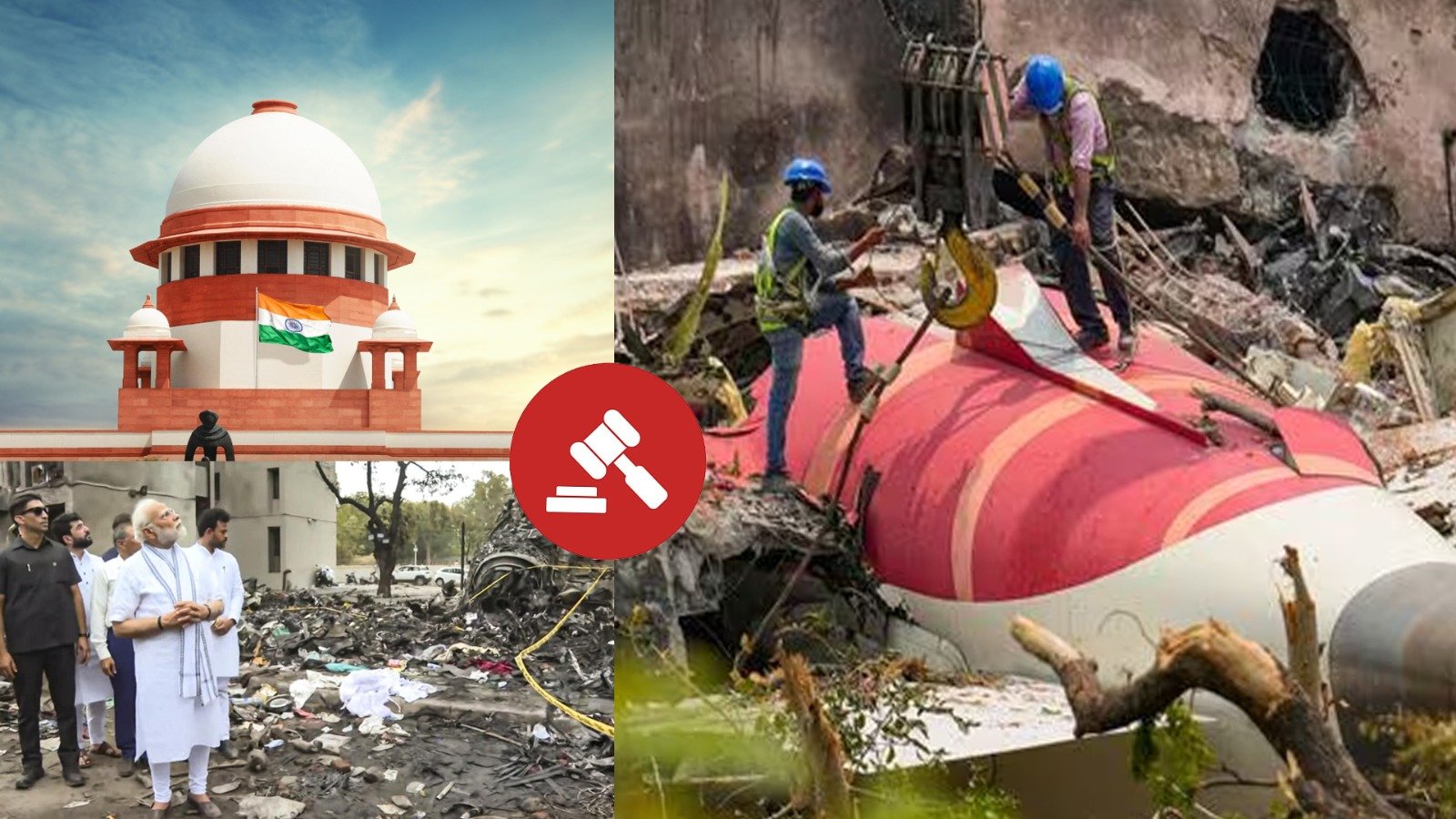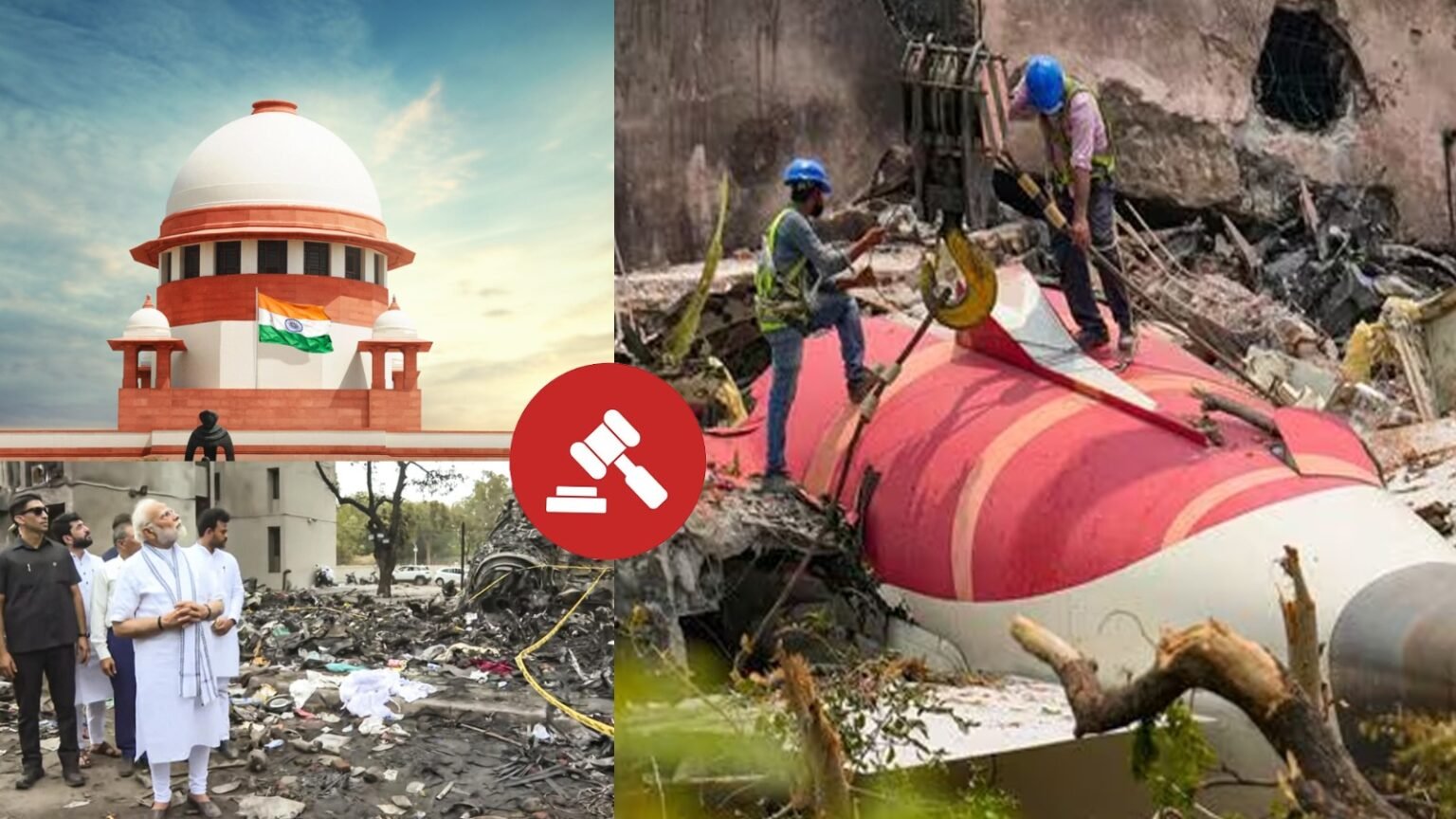– Ravi Prakash & Aditi Singh Tomar
An Air India flight from Ahmedabad to London, carrying 242 passengers and crew, crashed shortly after take-off on Thursday (June 12, 2025) afternoon. Barring one miracle survivor, no one else could be rescued. Former Gujarat Chief Minister Vijay Rupani was among those killed in the crash. Air India confirmed that 241 out of 242 people aboard the flight have died.
The passengers of the plane were identified as 169 Indian nationals, 53 British nationals, seven Portuguese nationals and one Canadian national, Air India said. The airline said the survivor is a British national of Indian origin.
The Boeing 787-8 aircraft took off at 1:38 p.m. Five minutes later, the aircraft plummeted into the B.J. Medical College hostel mess 5km from the airport, as over 100 students were gathered for lunch. A towering plume of smoke was visible from afar after a massive explosion.
‘Mayday’ call by the pilot & its significance in aviation sector
The pilots reportedly gave a ‘Mayday’ call immediately after take-off, signalling a life-threatening emergency, but did not respond to subsequent calls made by the airport traffic control.
“Mayday” is the word used around the world to make a distress call via radio communications. Mayday signals a life-threatening emergency, usually on a ship or a plane, although it may be used in a variety of other situations. A typical distress call will start with mayday repeated three times, followed by all the relevant information that potential rescuers would need, including type and identity of craft involved, nature of the emergency, location or last known location, current weather, fuel remaining, what type of help is needed and number of people in danger.
“Mayday” got its start as an international distress call in 1923. It was made official in 1948. The idea for “mayday” because it sounded like the French word m’aider, which means “help me.” A mayday call is not something to be taken lightly. In the United States, it’s illegal to make a fake distress call. For situations that are less than life-threatening, one of several other urgent messages can be conveyed but not “Mayday”.
As widely reported and series of incidents took place, the London bound Boeing 787-8 Aircraft crashed within seconds from an altitude of mere 600 feet.
After meeting the sole survivor of the crash in hospital, Union Home Minister Amit Shah said none of the other passengers could be saved. “Due to the huge amount of fuel at 1.25 lakh litre and high temperature from the explosion, no one could be rescued,” he said. The survivor was identified as Vishwas Kumar Ramesh, who was travelling in the A11 seat of the Boeing 787 Dreamliner aircraft, heading to London with his brother.
As such tragic air crash & accidents can occur anywhere and in the territorial jurisdiction(s) of any other countries – which carries ‘nationals’ and ‘citizens’ from different jurisdiction(s) – it is imperative to ascertain the international framework, co-operation and other aspects including humanitarian assistance, rescue as well as compensation to the family and passengers etc.
Laws which govern the matter of international civil aviation sector
The laws that apply during international flights depend on a number of factors, including the country of registration of the aircraft, the country of departure, the country of destination, and the nationality of the passengers and crew. However, most international flights are subject to a set of international laws known as the “Chicago Convention on International Civil Aviation,” which was established in 1944 [hereinafter; Chicago Convention] and is overseen by the International Civil Aviation Organization (ICAO).
Chicago Convention:- Article 26 of the Chicago Convention contemplates investigation in the event of an accident to an aircraft of a of accident contracting State occurring in the territory of another contracting State, and involving death or serious injury, or indicting serious technical defect in the aircraft or air navigation facilities, the State in which the ~accident occur will institute an inquiry into the circumstances of the accident, In accordance, so far as it laws permit, with the procedure which may be recommended by the International Civil Aviation Organization. The State in which the aircraft is registered shall be given the opportunity to appoint observer to be present at the inquiry and the State holding the inquiry shall communicate the report and findings in the matter to that State.
The Montreal Convention 1999 (hereinafter; MC99)
The Montreal Convention establishes liability of the airline company in the case of death or injury to passengers, as well as in cases of delay, damage or loss of baggage and cargo. It unifies all of the different international treaty regimes covering airline liability that had developed haphazardly since 1929. MC99 is designed to be a single, universal treaty to govern airline liability around the world.
Article 17 of the MC99 states that the carrier is liable for damage sustained in case of death or bodily injury of a passenger upon condition only that the accident which caused the death or injury took place on board the aircraft or in the course of any of the operations of embarking or disembarking.
Article 21 of the MC99 works under a two-tier liability system that refers to compensation in terms of special drawing rights, or SDRs. SDRs are a national reserve asset that can be exchanged for usable currency. The first-tier states that the carrier is liable for up to 100,000 SDRs, which is roughly estimated to be $132,000, unless they can prove passenger negligence. The second-tier states that the injured passenger or their heir can receive compensation past 100,000 SDRs. However, once again, the airline may not be held liable if it proves it was not negligent or if it proves the accident stemmed from an unaffiliated third party, such as another passenger
Another important provision under MC99 is the Article 32 of it which states that in case of a death of person liable, an action for damages lies in accordance with the terms of this Convention against those legally representing his or her estate.
The Rome Convention: This treaty, signed in 1952, sets out rules for the liability of airlines in the event of injury or death of passengers during international flights. Article 22 of the Rome Convention states that in the event of the death of the person liable, an action in respect of liability under the provisions of this Convention shall lie against those legally responsible for his obligations.
Regulatory framework in India for the investigation of aviation accidents in India.
In India, Section 7 of the Aircraft Act, 1934 empowers the Government of India to make rules for investigation of accidents arising out of or in the course of the navigation in or over India of any aircraft, or anywhere of aircraft registered in India. As per the Act and in conformity with Article 26 of the Convention on International Civil Aviation, earlier the Air Safety Directorate of DGCA was carrying out the duties and responsibilities regarding investigation of aircraft accident and incidents. This was governed by the Aircraft Rules 1937.
AIRCRAFT (INVESTIGATION OF ACCIDENTS AND INCIDENTS) RULES, 2012
The Rules define the ‘accident’ under Rule 2(a) very comprehensively which seeks to distinguish between ‘manned aircraft’ and ‘unmanned aircraft’. It also defines the ‘serious injury’ under Rule 2 (z) separately and distinctly. In each case, the liability is contributory, depending upon the facts and circumstances including the extent of involvement, control and negligence on part of various actors including the manufacturer of such airlines, companies operating such airlines, regulatory authorities, airport operator/ facilitator company as well as passenger’s / injured person role.
The definition of ‘serious injury’ by its very nature contemplates different situations, medical conditions and impact on internal and external organ including the exposure to the infectious and injurious radiations. However, it does not contemplate a situation where a person/ passenger is specifically needs special attention as they are allergen to some bio, environmental or other materials which are on aircraft.
The Rule 5 of the Aircraft (investigation of accidents and incidents) Rules, 2012 casts a duty to investigate such incidents/ accidents which occurs in territory of India irrespective of the fact as whether such aircraft is registered in India or not. It essentially based upon the principle of territoriality and sovereignty.
It mandates that the Central Government shall institute an investigation into the circumstances of the accident and shall be responsible for conducting the investigation.
The principle of ‘nationality’ or ‘protecting the interest of its citizens’ is incorporated under Rule 5 of it where it empowers the Central Government to institute an investigation into the circumstances of the accident/ serious injury to any ‘Indian’. The principle of ‘international co-operation’ and extra- territoriality finds its place when the scene of accident is in international waters/ and high sea even if the cases where an aircraft is not registered in India nor operated by any Indian operator.
The central and specialised agency to investigate such air crashes, the Govt. of India has established ‘Aircraft Accident Investigation Bureau’ [hereinafter; AAIB] under Rule 8. The rule further contemplates a kind of international co-operation and its obligation under the international legal framework to make the report made public by the Govt. of India to ICAO if the mass of the aircraft involved in accident or incident is more than 5,700 kg. It is also under obligation to take into account the other reports and committee’s report made by international bodies, or any committee of Inquiry or foreign countries so as to ensure the principle of comity. It also envisages to formulate safety recommendation on the basis of safety studies, including induction of new technology to enhance safety, conducted from time to time. The AAIB establish and maintain an accident and incident database to facilitate the effective analysis of information on actual or potential safety deficiencies obtained, including that from its incident reporting systems, and to determine any preventive actions required.
Under the rules framed in tune with the international practices and standards, the AAIB has been mandated for immediate and unrestricted access to all relevant evidence from any agency / organisation without seeking prior consent from judicial bodies or other Government authorities. The Investigator-in-Charge is responsible for conduct of Investigation into circumstances of the accident or serious incident. The independence, impartiality of the committee is secured through various provisions besides the committee is mandated to carry out the scientific /fact based investigation under the Rule. The Initial Notification of the occurrence is sent to the State of Registry, State of Operator, State of Manufacturer and State of Design of involved aircraft or other concerned States in accordance with Aircraft (Investigation of Accidents and Incidents) Rules, 2017 and ICAO Annex 13. The Accredited Representatives from the concerned States associate in the Investigation undertaken by AAIB.
Assessment of Investigation Requirements
The Investigation team appointed by AAIB reviews all evidence collected during Initial stages to make assessment about requirement of detailed examination to be carried out on any components or equipment. In case of requirement of any specialised expertise, like type qualified pilot or engineer, aviation medicine specialist, licensed ATCO etc., subject-matter experts of relevant area from Industry are associated in the investigations. In accordance with ICAO Annex 13, accredited representatives from concerned States and their technical advisers are consulted during the investigation for any examination or testing that may be required to be carried out at facilities situated in those States.
Compensation to the Passengers
For the passengers traveling, ministry of civil aviation has guidelines for the settlement of claim for compensation on Accidents. The govt. has decided the guidelines framed under DoT will be adopted by all ministries/departments. Besides the compensation announced by the govt. authorities, each passenger or family of the victim is also entitled to compensation from operating company as well as travel insurance which has been secured by the passengers themselves.
***
[Declaration – This note is not exhaustive nor constitute ‘legal advice’ in any manner. It just give overview of the legal framework. The readers are advised to have legal opinion and advise based upon their unique facts and circumstances of the case.]
* Ravi Prakash is an Advocate on Record and practice law at Supreme Court of India & Aditi works as researcher with O’RP – Office of Ravi Prakash.
Keywords: Air India Plane Crash, Ahmedabad Plane Crash, Ahmedabad Air India Plane Crash, International Civil Aviation, International Airspace, Air India Boeing 787 Dreamliner Crash, Airbus, Boeing, Airlines and Public Safety Law, Aviation Laws and Regulations












